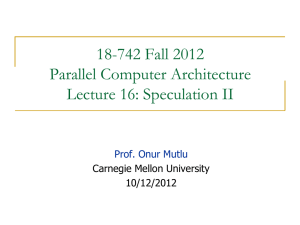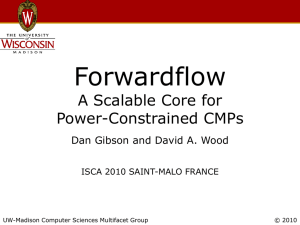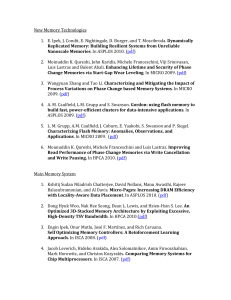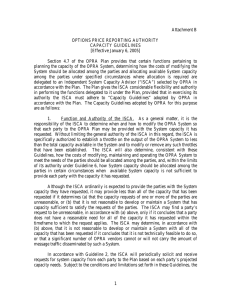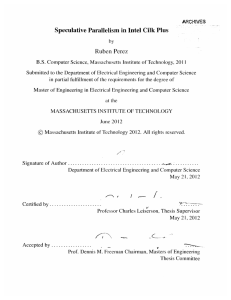18-742 Spring 2011 Parallel Computer Architecture Lecture 20: Transactional Memory Prof. Onur Mutlu
advertisement
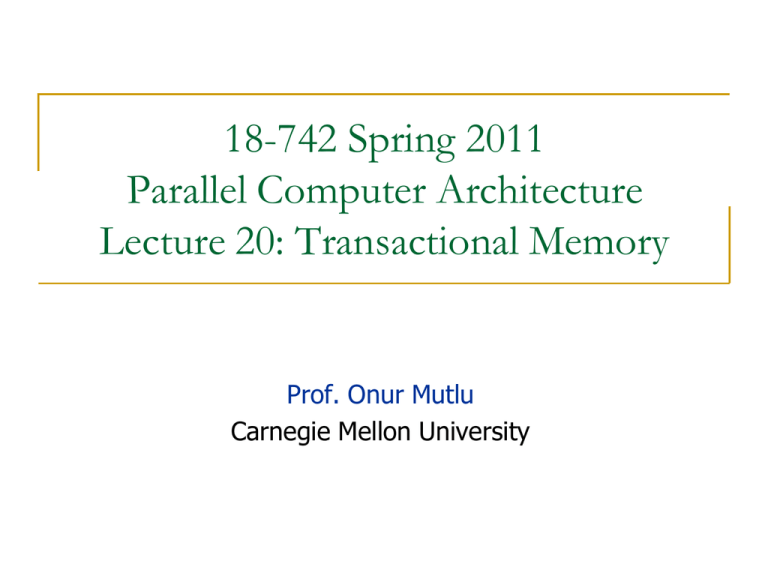
18-742 Spring 2011 Parallel Computer Architecture Lecture 20: Transactional Memory Prof. Onur Mutlu Carnegie Mellon University Reviews Due Last Time (March 21, before class) Arvind and Nikhil, “Executing a Program on the MIT TaggedToken Dataflow Architecture,” IEEE TC 1990. Gurd et al., “The Manchester prototype dataflow computer,” CACM 1985. Due Saturday (March 26) Sankaralingam et al., “Exploiting ILP, TLP and DLP with the Polymorphous TRIPS Architecture,” ISCA 2003. Burger et al., “Scaling to the End of Silicon with EDGE Architectures,” IEEE Computer 2004. 2 Speculative Parallelization Concepts Idea: Execute threads unsafely in parallel Hardware or software monitors for data dependence violations If data dependence ordering is violated Threads can be from a sequential or parallel application Offending thread is squashed and restarted If data dependences are not violated Thread commits If threads are from a sequential order, the sequential order needs to be preserved threads commit one by one and in order 3 Multiscalar Processors (ISCA 1992, 1995) Exploit “implicit” thread-level parallelism within a serial program Compiler divides program into tasks Tasks scheduled on independent processing resources Hardware handles register dependences between tasks Memory speculation for memory dependences Compiler specifies which registers should be communicated between tasks Hardware detects and resolves misspeculation Franklin and Sohi, “The expandable split window paradigm for exploiting fine-grain parallelism,” ISCA 1992. Sohi et al., “Multiscalar processors,” ISCA 1995. 4 Four Issues in Speculative Parallelization How to deal with unavailable values: predict vs. wait How to deal with speculative updates: Logging/buffering How to detect conflicts How and when to abort/rollback or commit 5 Transactional Memory Idea: Programmer specifies code to be executed atomically as transactions. Hardware/software guarantees atomicity for transactions. Motivated by difficulty of lock-based programming 6 Locking Issues Locks: objects only one thread can hold at a time Correctness issues Organization: lock for each shared structure Usage: (block) acquire access release Under-locking data races Acquires in different orders deadlock Performance issues Conservative serialization Overhead of acquiring Difficult to find right granularity Blocking 7 Locks vs. Transactions Lock issues: – Under-locking – Acquires in different orders – Blocking – Conservative serialization How transactions help: + Simpler interface + No ordering + Can cancel transactions + Serialization only on conflicts 8 Transactional Memory Transactional Memory (TM) allows arbitrary multiple memory locations to be updated atomically Basic Mechanisms: Isolation: Track read and writes, detect when a data conflict occurs between transactions Version management: Record new/old values Atomicity: Commit new values or abort back to old values Issues the same as other speculative parallelization schemes Logging/buffering Conflict detection Abort/rollback Commit 9 Four Issues in Transactional Memory How to deal with unavailable values: predict vs. wait How to deal with speculative updates: Logging/buffering How to detect conflicts How and when to abort/rollback or commit 10 Many Variations of TM Software Hardware High performance overhead, but no virtualization issues What if buffering is not enough? Context switches, I/O within transactions? Need support for virtualization Hybrid HW/SW Switch to SW to handle large transactions and buffer overflows 11 Initial TM Ideas Load Linked Store Conditional Operations Lock-free atomic update of a single cache line Used to implement non-blocking synchronization Alpha, MIPS, ARM, PowerPC Load-linked returns current value of a location A subsequent store-conditional to the same memory location will store a new value only if no updates have occurred to the location Herlihy and Moss, ISCA 1993 Instructions explicitly identify transactional loads and stores Used dedicated transaction cache Size of transactions limited to transaction cache 12 Herlihy and Moss, ISCA 1993 13 TM Research Issues How to virtualize transactions (without much complexity) Handling I/O within transactions Ensure long transactions execute correctly In the presence of context switches, paging No problem with locks Semantics of nested transactions (more of a language/programming research topic) Does TM increase programmer productivity? Does the programmer need to optimize transactions? 14 Readings: Data Flow Review papers Gurd et al., “The Manchester prototype dataflow computer,” CACM 1985. Arvind and Nikhil, “Executing a Program on the MIT Tagged-Token Dataflow Architecture,” IEEE TC 1990. Recommended papers Dennis and Misunas, “A Preliminary Architecture for a Basic Data Flow Processor,” ISCA 1974. Treleaven et al., “Data-Driven and Demand-Driven Computer Architecture,” ACM Computing Surveys 1982. Veen, “Dataflow Machine Architecture,” ACM Computing Surveys 1986. Patt et al., “HPS, a new microarchitecture: rationale and introduction,” MICRO 1985. 15
